rom the “whimsigoth” craze sweeping design circles to mainstream embrace of near-black paint, a Gothic living room no longer feels like an eccentric outlier—it’s the fastest route to drama, depth, and undeniable character. Designers praise the style for its rich storytelling power, layering centuries-old motifs with modern comfort and technology. If you’re ready to trade bland beige for brooding beauty, the ideas below show just how versatile (and livable) Gothic can be.
1. Gothic Living Room Wrapped in Dramatic Black Walls

A jet-hued backdrop instantly anchors a Gothic living room, allowing every gilded frame and velvet cushion to glow like candlelight. Unlike past fears that black shrinks a room, designers point out that deep tones visually recede, making wall lines blur and ceilings feel higher. Use ultra-matte paint to absorb glare, then break up the expanse with ornate cornices or a carved mantle for texture. For rental spaces, try peel-and-stick chalkboard wallpaper in charcoal—easy to remove but still perfectly moody. Balance darkness with layered lighting and reflective accents so the space feels enveloping, not gloomy.
2. Gothic Living Room Draped in Velvet Sofas and Curtains
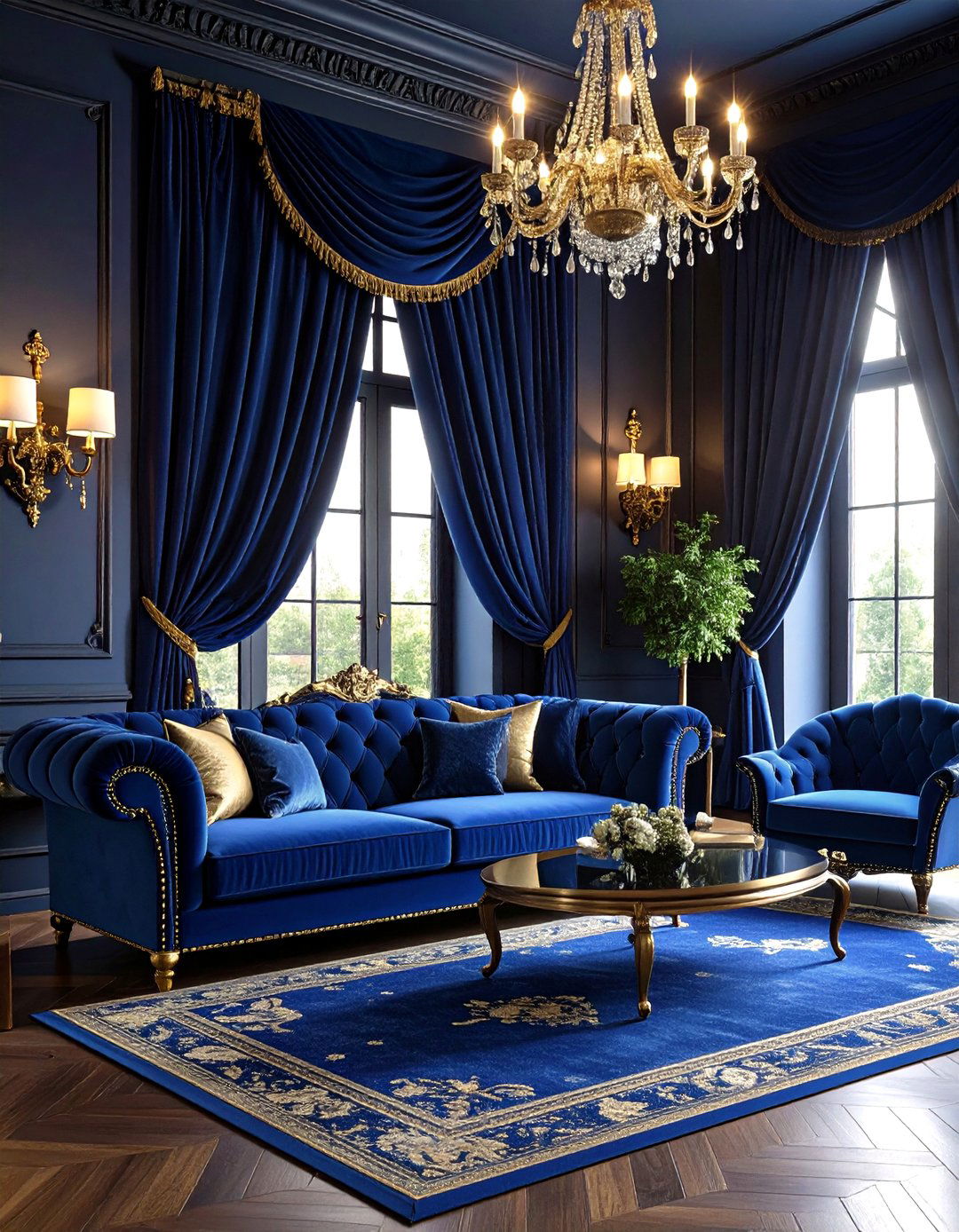
Consider sinking into a midnight-blue velvet sofa while thick, floor-puddling curtains hush outside light—the tactile richness is quintessential Gothic. Designers love velvet for its light-absorbing pile and subtle sheen that lends furniture a timeless, salon-worthy gravitas. Pair jewel-tone upholstery with black-out velvet drapes on ceiling-mounted tracks to heighten vertical drama. In warmer months, swap curtains for lighter sheers but keep the sofa: its plush hand makes even minimalist rooms feel decadent. A quick lint roll and occasional steam keep pile flawless, ensuring your Gothic living room stays luxe, not fussy.
3. Gothic Living Room Gleaming with Ornate Mirrors
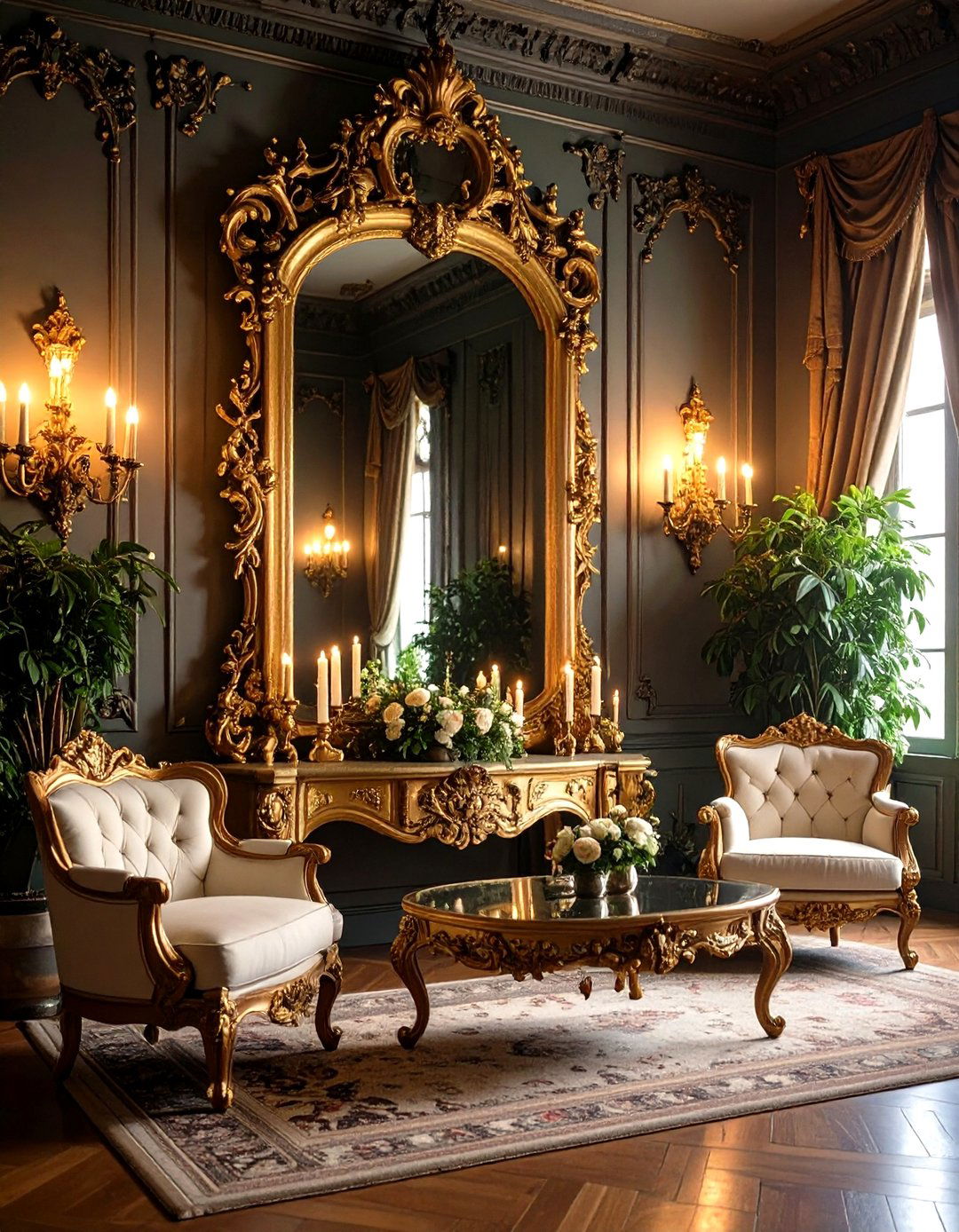
An oversized baroque mirror—think acanthus leaves, burnished gold, and just a hint of age-spotted glass—bounces candlelight across dark walls, expanding the room while amplifying the drama. Lean a tall mirror casually on the floor for a modern twist, or flank a mantel with symmetrical gilt frames to echo cathedral symmetry. Antique stores and online auctions abound with Gothic Revival pieces whose craftsmanship outshines mass-produced replicas. Keep nearby décor minimal so the mirror reads as art rather than clutter. The result is a Gothic living room that feels twice its size and steeped in old-world glamour.
4. Gothic Living Room Lit by Candle Chandeliers

Nothing says “gothic grandeur” like wrought-iron arms cradling flickering tapers overhead. A candle chandelier radiates a warm, dancing glow that flatters skin tones and wood grains alike. If open flame isn’t practical, swap wax sticks for dimmable LED candles set to a gentle 2200 K color temperature—authentic ambience, zero soot. For a DIY route, thrift a brass fixture, spray it matte black, and add clip-on candle sleeves to disguise wiring. Suspend it low over a coffee table to create an intimate halo; keep wider walkways clear so the piece feels inviting, not imposing.
5. Gothic Living Room Framed by Stained-Glass Windows

Few elements conjure instant mystique like jewel-tone panes catching afternoon sun. Modern manufacturers now offer double-glazed, energy-efficient Gothic arches that mimic medieval originals while meeting today’s insulation codes. In rentals, hang removable lead-look window film or mount salvaged church panels on decorative brackets in front of standard glass. The colored light dapples wood floors and velvet cushions, transforming the everyday into something ethereal. Incorporate simpler furnishings so the windows remain the undisputed focal point of your Gothic living room.
6. Gothic Living Room Accented with Rich Jewel Tones

Surprisingly, a Gothic palette isn’t limited to black. Deep emerald, oxblood, and amethyst punch through darkness, adding regal warmth. Use a single saturated tone on a tufted ottoman or oversized area rug, then echo hints in artwork or throw pillows. Designers recommend matte finishes for walls and lustrous fabrics for accents to build contrast within the same hue family. Jewel tones also photograph beautifully—ideal if you love sharing interior shots online. The key is restraint: let one dominant color sing while supporting shades whisper around it.
7. Gothic Living Room Featuring Victorian Antique Furniture

Carved oak settees, barley-twist tables, and quatrefoil bookcases embody the romance of Gothic Revival. Vintage pieces offer solid craftsmanship and ecological sustainability—buy once, adore forever. When mixing antiques with modern tech, hide cables in hollow table legs or behind floor-length textiles so the illusion remains unbroken. Reupholster seats in washable performance velvet to marry practicality with period style. A single statement antique can elevate an otherwise contemporary space into a bona fide Gothic living room without tipping into theme-park territory.
8. Gothic Living Room Embracing Whimsigoth Maximalism
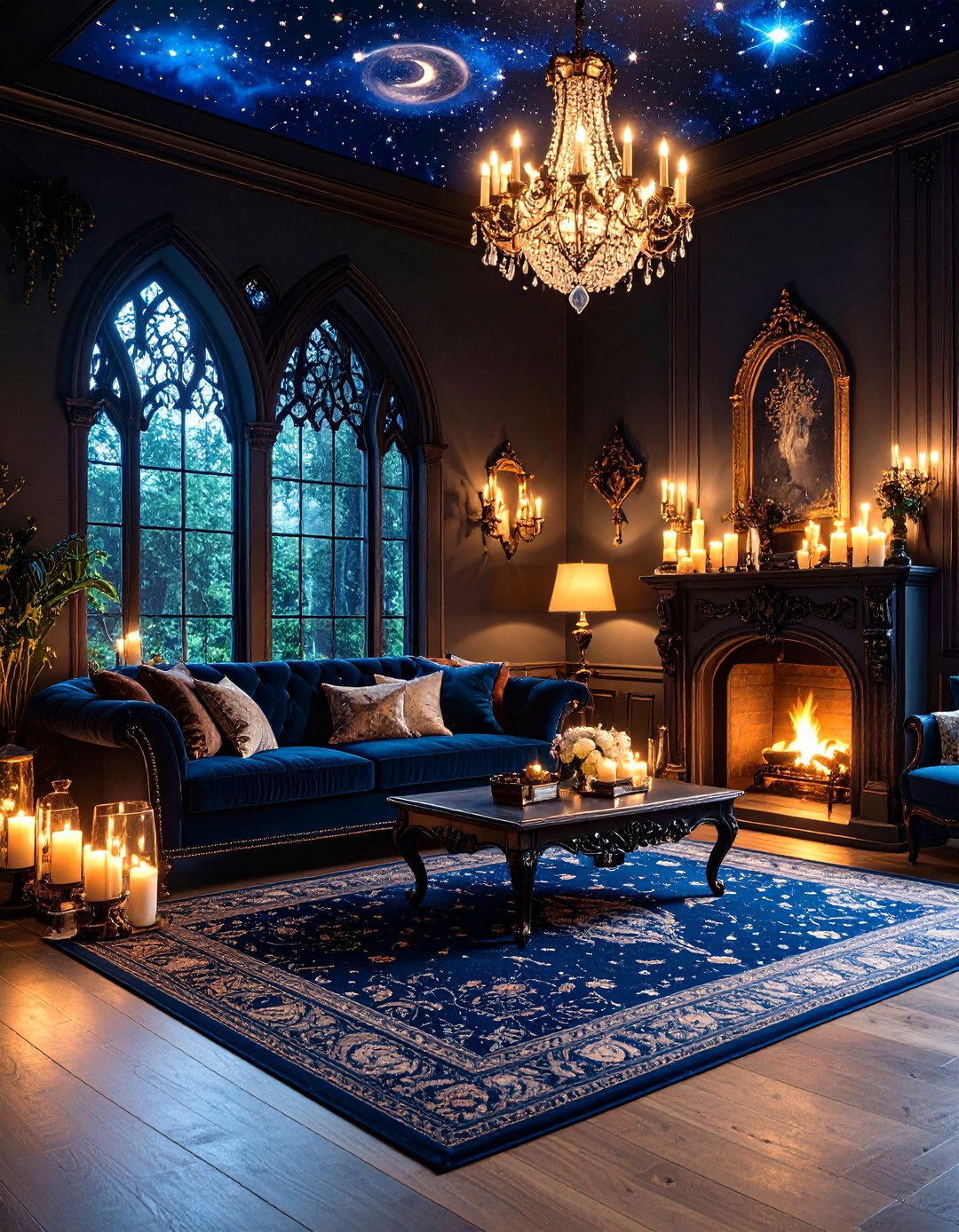
Unlike strict period re-creations, whimsigoth blends celestial prints, crystal clusters, and vintage lace with the genre’s signature darkness. Layer patterned rugs, tasseled throws, and mixed-metal candlesticks until the room hums with visual storytelling. This maximalist approach lets renters play with peel-and-stick wallpapers and thrift-store treasures that can evolve over time. The goal isn’t clutter for clutter’s sake but curated abundance—a space where every object feels talismanic. If minimalism leaves you cold, whimsigoth is your ticket to an expressive, joyfully haunted living room.
9. Gothic Living Room Meets Modern Minimalism
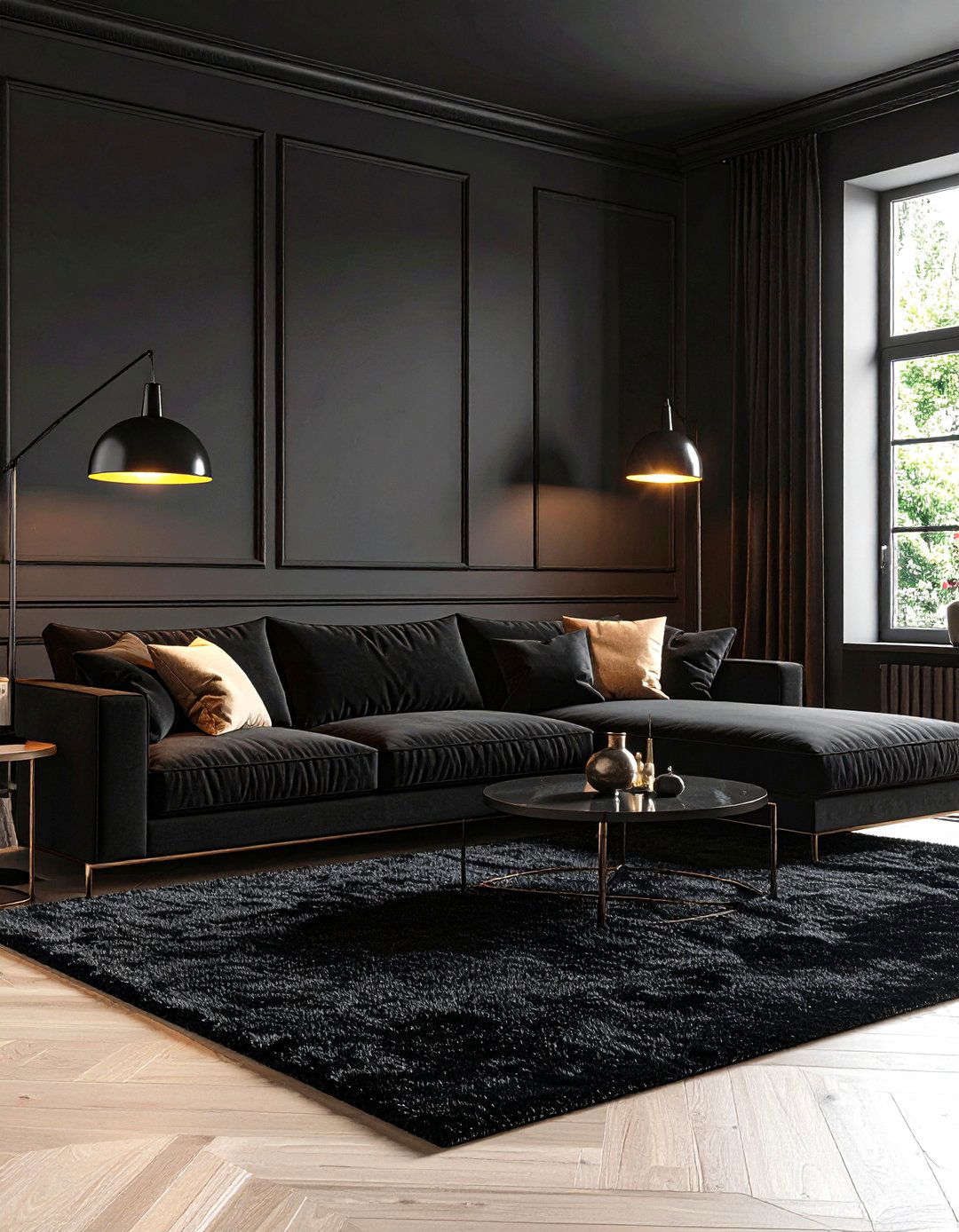
For purists who love clean lines, pair a low-slung black sectional with one sculptural floor lamp and a charcoal wool rug. The absence of ornate detailing lets shadows become the décor, emphasizing proportion and negative space. Use hidden LED strips in baseboards to give furniture a floating effect, echoing the weightlessness of Gothic arches without literal replication. Minimalist Gothic feels moody yet uncluttered—perfect for lofts or small condos where every square foot counts. Choose two luxurious materials (say, leather and brass) and repeat them for cohesive restraint.
10. Gothic Living Room with a Dark Academia Botanical Twist

Plaid throws, leather-bound books, and pressed ferns under glass marry academic charm with gothic gloom. Paint bookcases espresso, tuck vintage globe lighting into shelves, and display trailing ivy to soften hard edges. Dark greenery thrives in lower light conditions, reinforcing the moody palette while purifying air. Layer classical busts and brass magnifying glasses to suggest a centuries-old scholar’s retreat—then stream your modern playlist through discreet smart speakers. Dark academia turns a Gothic living room into a study in intellectual allure.
11. Gothic Living Room Celebrating Arched Architecture
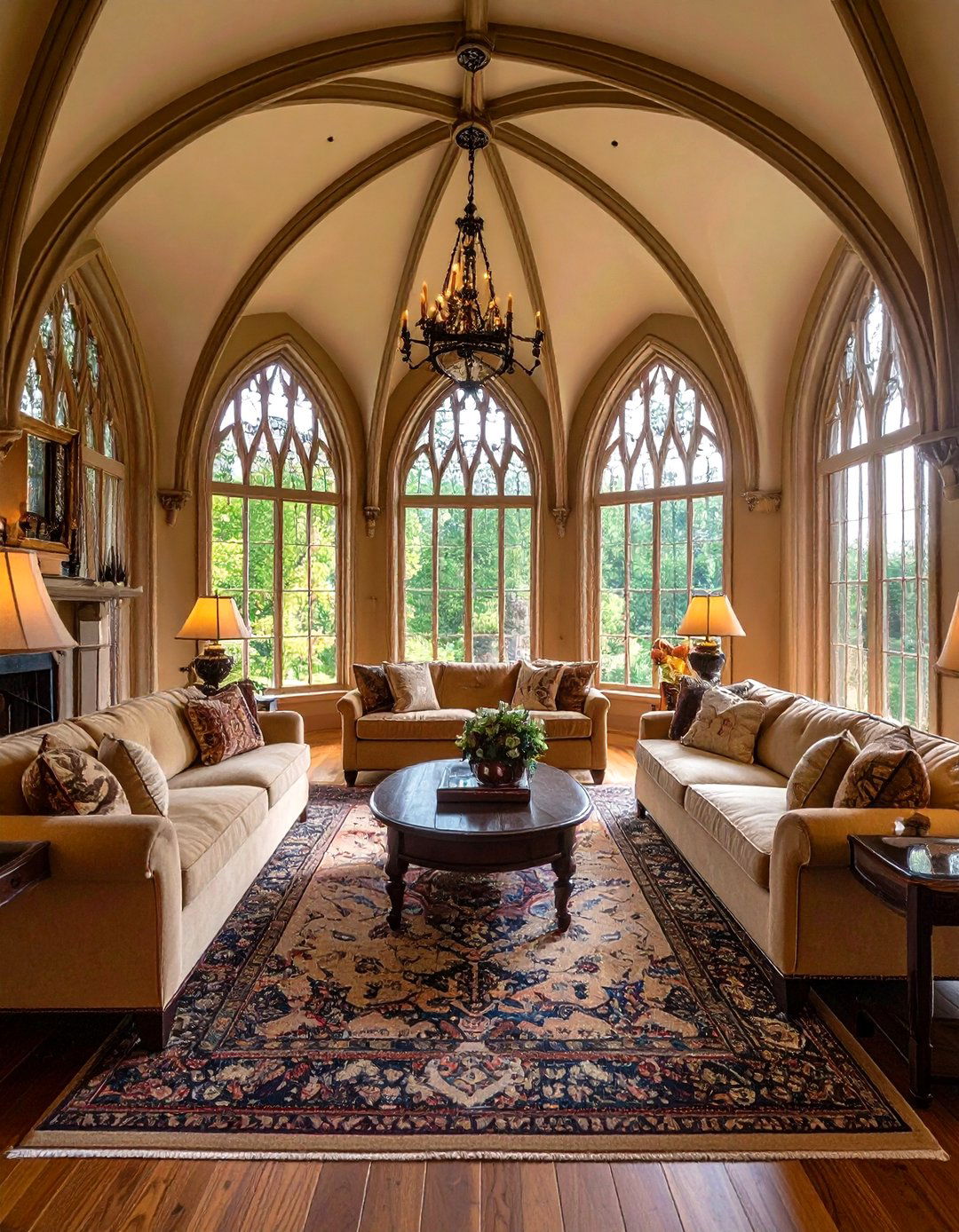
Pointed arches draw eyes upward, mimicking cathedral vaults even in modest homes. If your walls are flat, create the illusion with MDF molding nailed over drywall and painted to match. For renters, adhesive EVA foam arches peel off cleanly later. Frame curtained bay windows with arch shapes to establish rhythm and verticality; repeat the motif in mirror tops or cabinet doors for cohesion. The result is a Gothic living room that feels taller, lighter, and unmistakably medieval without structural renovations.
12. Gothic Living Room Highlighting Wrought-Iron Details

Slim iron candlesticks, scrolling side tables, and lattice radiator covers provide a black-on-black textural layer that reads sophisticated, not industrial. Powder-coat thrifted brass pieces in matte iron finish for budget-friendly unity. A single wrought-iron cage pendant over the coffee table grounds the seating area; echo its geometry in fireplace tools or photo frames. Iron’s cool undertone balances warm woods and plush fabrics, preventing the palette from feeling muddy. Proper felt pads protect floors, ensuring durability that matches iron’s centuries-long legacy.
13. Gothic Living Room Transformed by Damask Wallpaper
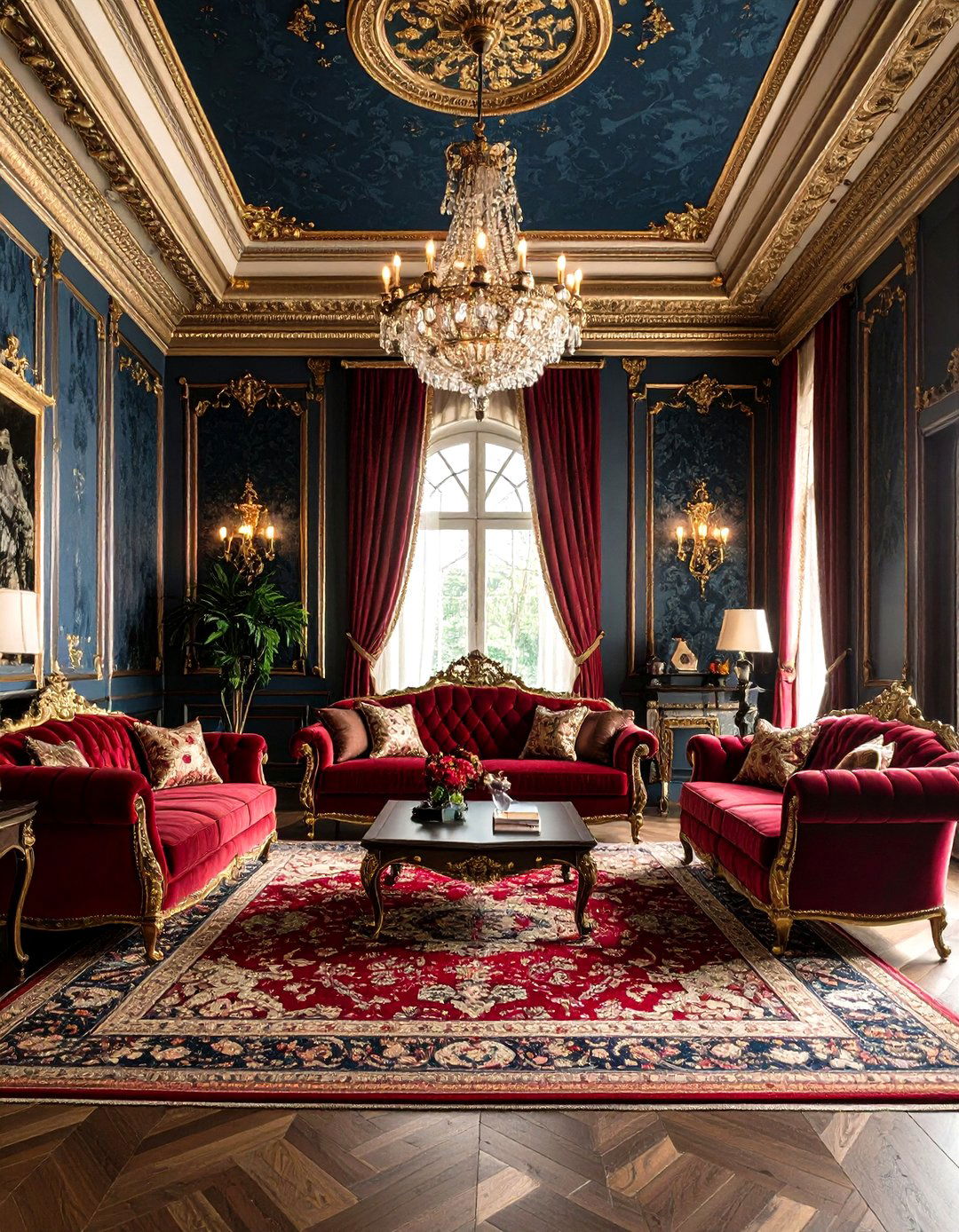
Surprisingly, a roll of bold, tone-on-tone damask can shift an entire room from bland to baronial. Choose flocked or embossed papers for tactile depth; in high-humidity climates, look for scrubbable vinyl versions that mimic fabric. Paper just one wall behind the sofa to save money and avoid pattern overload. Finish edges with picture-rail molding painted the wall color for a built-in look. When combined with sleek furniture, damask reads fresh rather than fusty, giving your Gothic living room a museum-quality backdrop.
14. Gothic Living Room Glowing with Layered Lighting
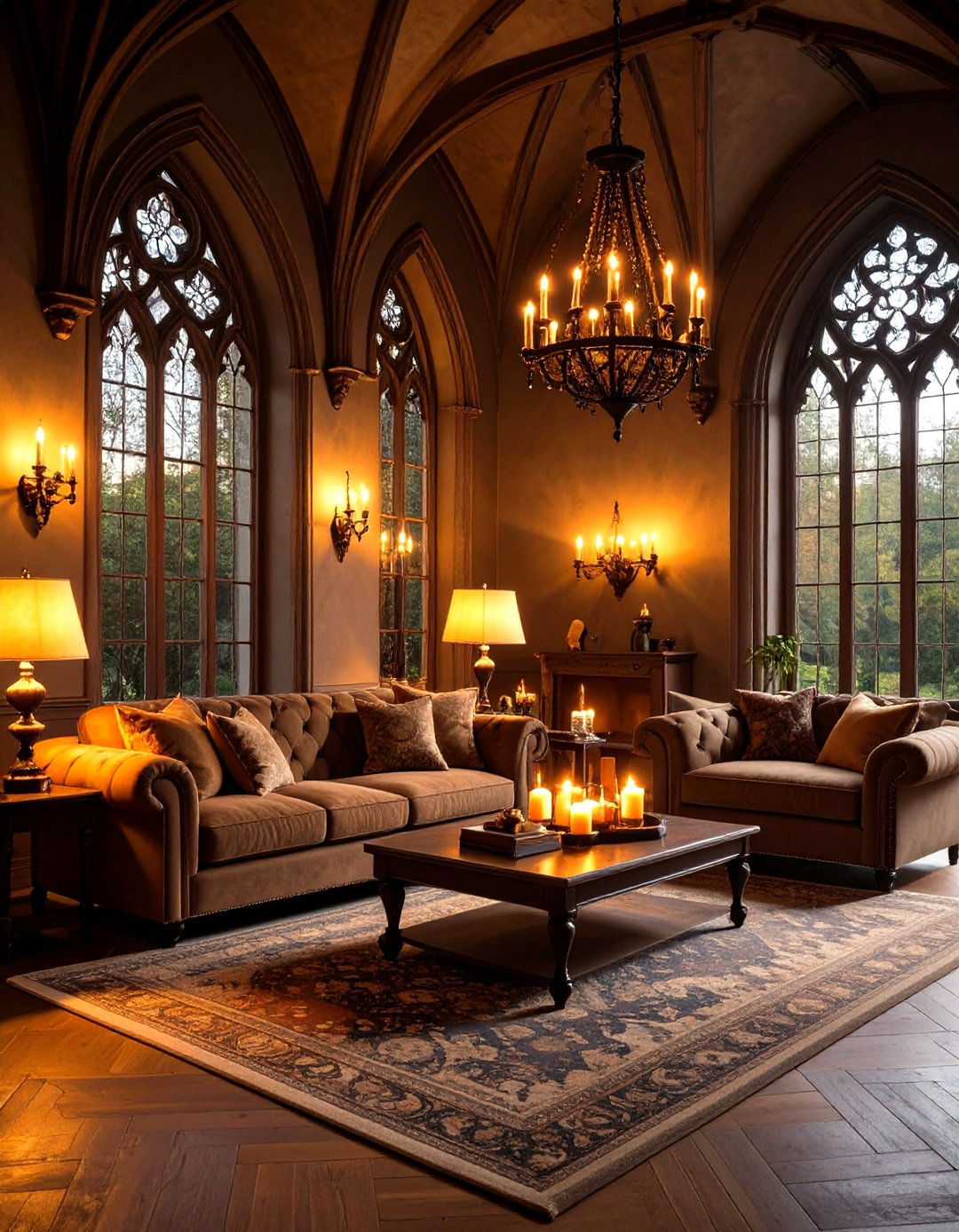
Certainly, even the darkest palette needs strategic illumination. Combine low-sitting table lamps with flicker-mode bulbs, picture lights that highlight art, and dimmable sconces aimed upward to recreate vaulted-ceiling ambiance. Smart bulbs let you shift from warm amber for movie night to cooler white for reading—all via voice command. Designers warn that a single overhead fixture flattens texture; multiple sources reveal the nuances of velvet, wood grain, and plaster. Thoughtful layering turns a Gothic living room into a stage where every object enjoys its own spotlight.
15. Gothic Living Room Showcasing Sculptural Art and Curiosities
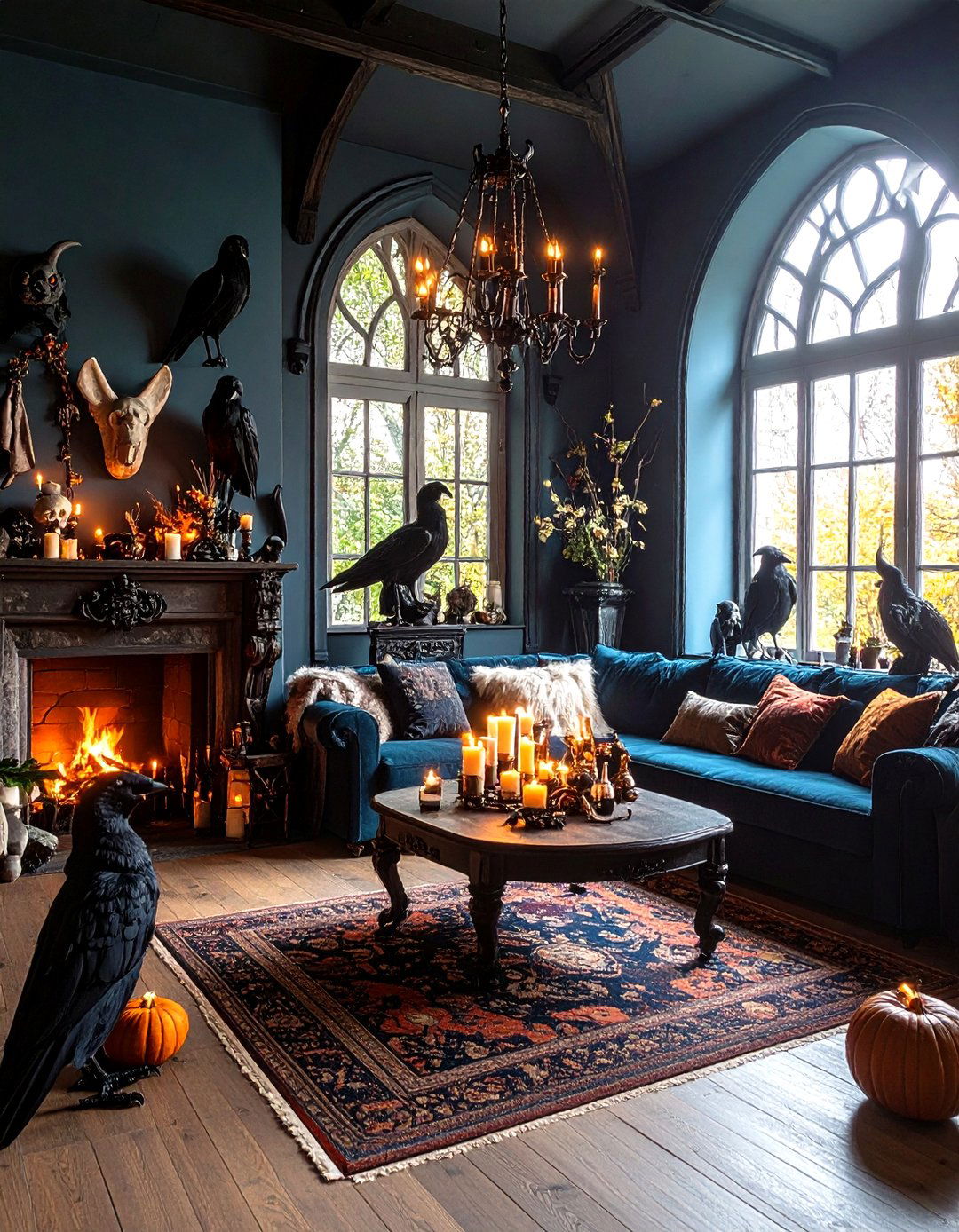
Taxidermy ravens, plaster gargoyles, and iron candelabra can toe the line between chic and kitsch. Keep balance by limiting oddities to one curated niche—perhaps a recessed shelf backed in ebony paint. Pair macabre pieces with soft elements like lace runners or velvet poufs to temper severity. Underlit glass cloches add museum drama without dusting hassles. This curated cabinet-of-curiosities approach transforms a Gothic living room into a personal gallery, sparking conversation without overwhelming everyday function.
16. Gothic Living Room Layered with Luxe Textures

Mix leather club chairs, faux-fur throws, and tufted velvet ottomans to entice both sight and touch. Texture keeps a monochrome palette from feeling flat, while contrasting sheens echo candlelight. Designers suggest repeating each material at least twice—leather on chairs and a tray, fur on a pillow and stool—for deliberate cohesion. In households with kids or pets, choose performance fabrics treated for stain resistance; their matte finish actually enhances Gothic matte-and-shine interplay. The result is a living room that feels indulgent yet resilient.
17. Gothic Living Room Elevated by Metallic Accents
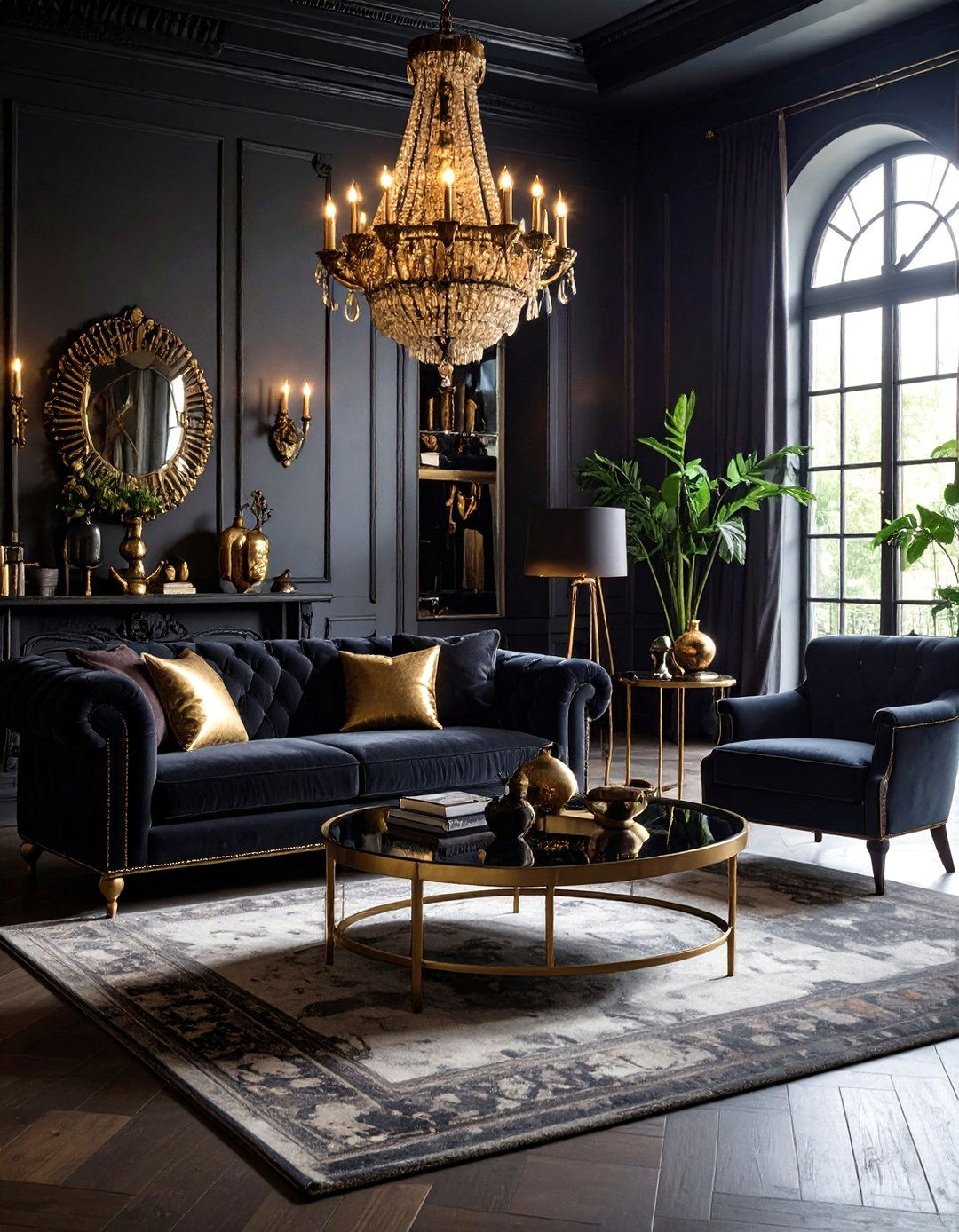
Gold leaf, antique brass, and aged pewter catch even minimal light, punctuating dark walls like stars in a night sky. Swap plain switch plates for ornate brass versions, or spray-paint ceiling medallions in aged silver to crown a chandelier. The trick is scale: a few oversized metallic pieces feel more curated than many tiny trinkets. Warm metals also balance cool black paint, ensuring your Gothic living room feels sumptuous, not severe.
18. Gothic Living Room Anchored by a Statement Fireplace
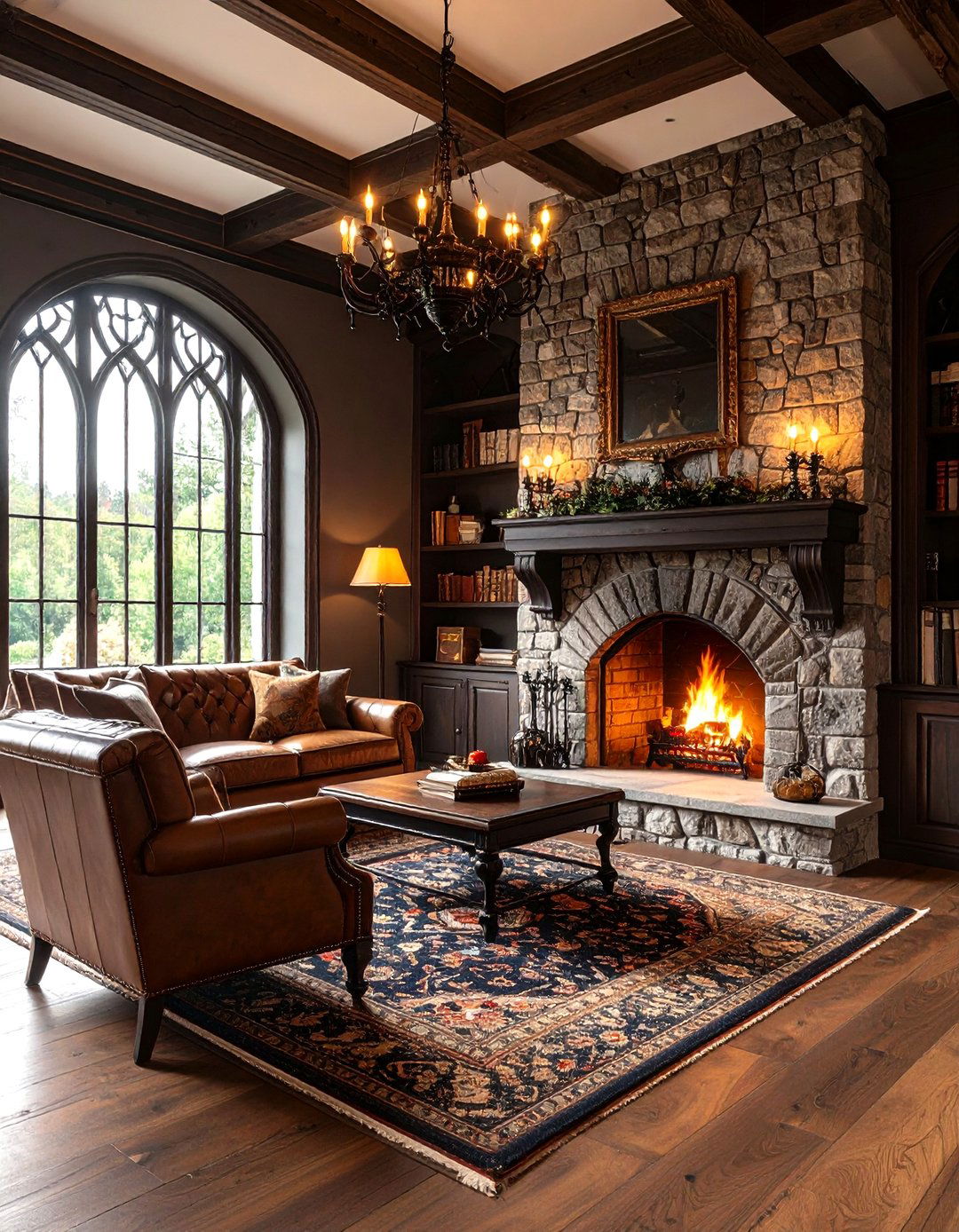
After all, the hearth was the medieval hub. Carve out a focal point with a cast-stone surround, then dark-wax it for antiqued depth. No chimney? An electric insert inside a salvaged mantel delivers flame visuals minus smoke. Display wrought-iron andirons even if purely decorative—they reinforce authenticity. Arrange seating to face the fire, creating a naturally intimate conversation pit that banishes the gloom stereotype. Guests won’t want to leave your brooding yet cozy Gothic living room.
19. Gothic Living Room Showcasing a Monochromatic Dark Palette
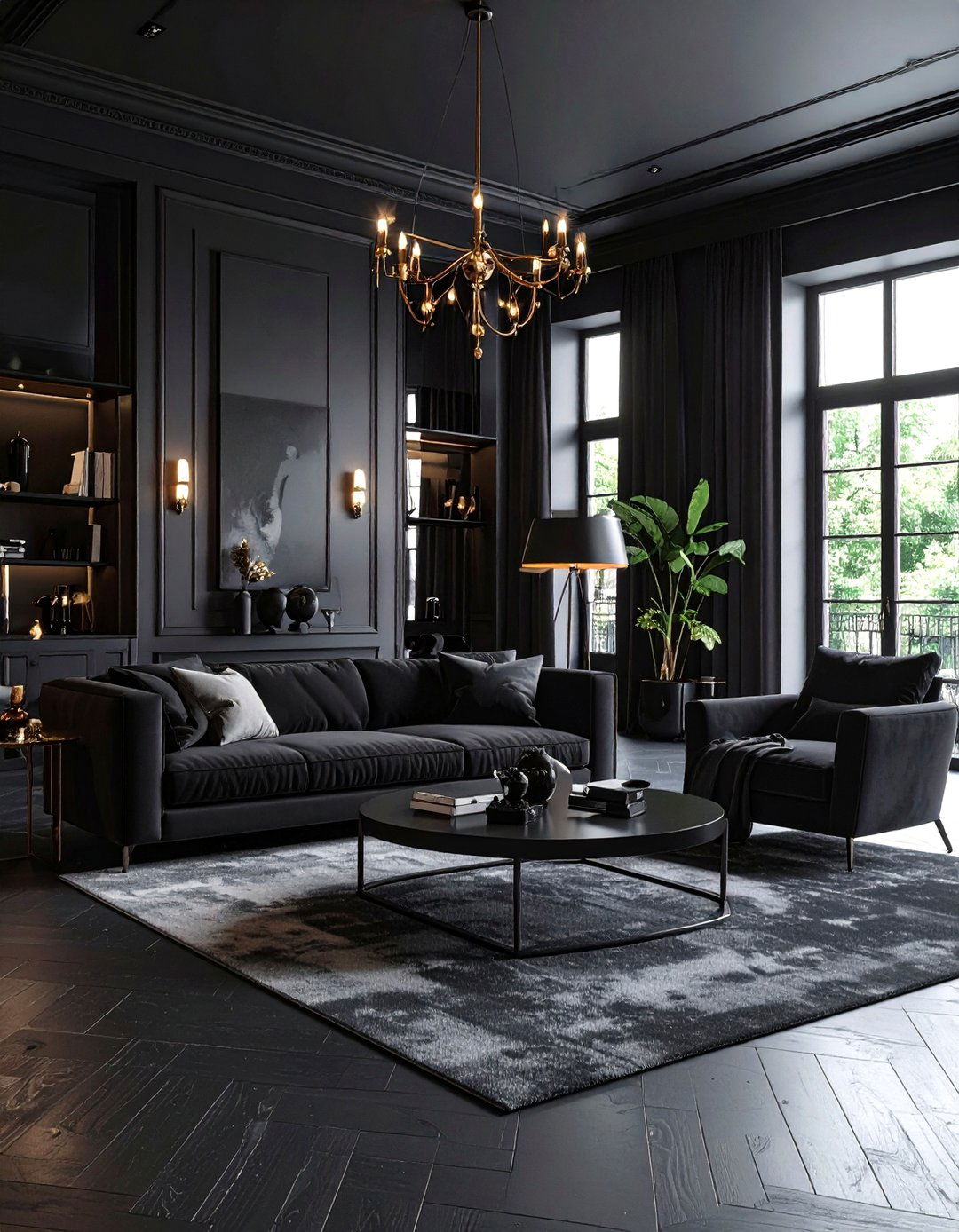
Owing to current color theory trends, designers increasingly champion single-hue rooms for serenity and impact. A charcoal-on-charcoal scheme unifies mismatched furniture and allows silhouettes to stand out. Vary finishes—eggshell on walls, satin on trim, velvet on upholstery—to prevent monotony. Add a single contrasting material like smoked glass or chrome for polishing effect. The result is a Gothic living room that feels cohesive, sophisticated, and surprisingly calming.
20. Gothic Living Room Solutions for Small Apartments

Looking to conjure drama in a studio? Paint just the window wall black to create depth and let natural light bounce off the opposite white walls. Opt for multipurpose storage ottomans upholstered in dark chenille and choose leggy furniture that exposes more floor, visually enlarging the room. Mirrors opposite the windows double perceived space while staying true to Gothic flair. Renters can rely on removable wallpaper, battery sconces, and thrifted accessories to achieve the look without violating lease terms. Even 500 square feet can house a fully fledged Gothic living room when every piece earns its keep.
Conclusion:
Dark décor no longer equals dreary. By weaving together mattes and metals, arches and LED strips, velvet and living greenery, a Gothic living room becomes a rich narrative—one that honors history while embracing modern comfort. Whether you commit to black walls or simply hang a candle chandelier, each idea above proves that shadow can be as welcoming as light when handled with intention and heart.



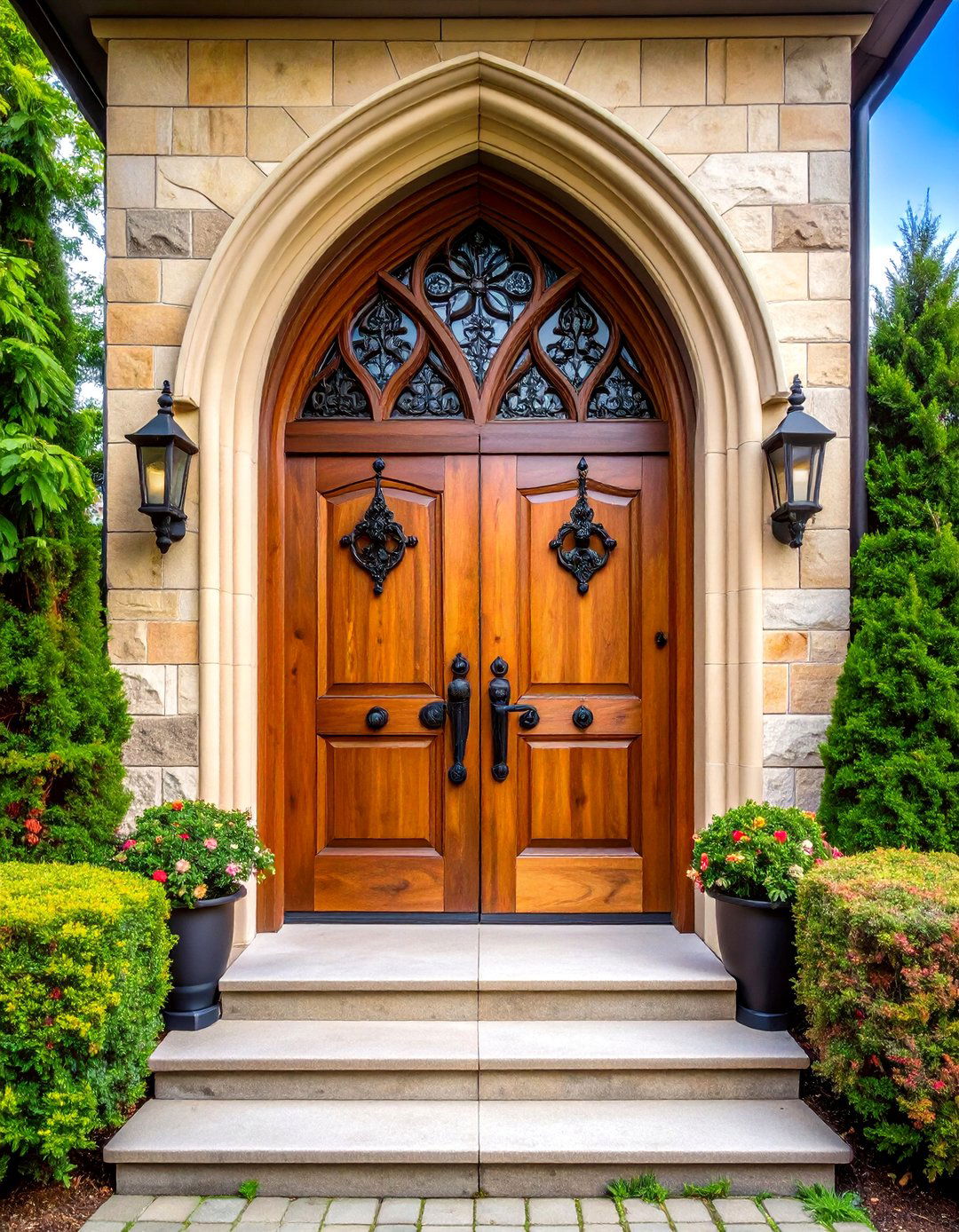
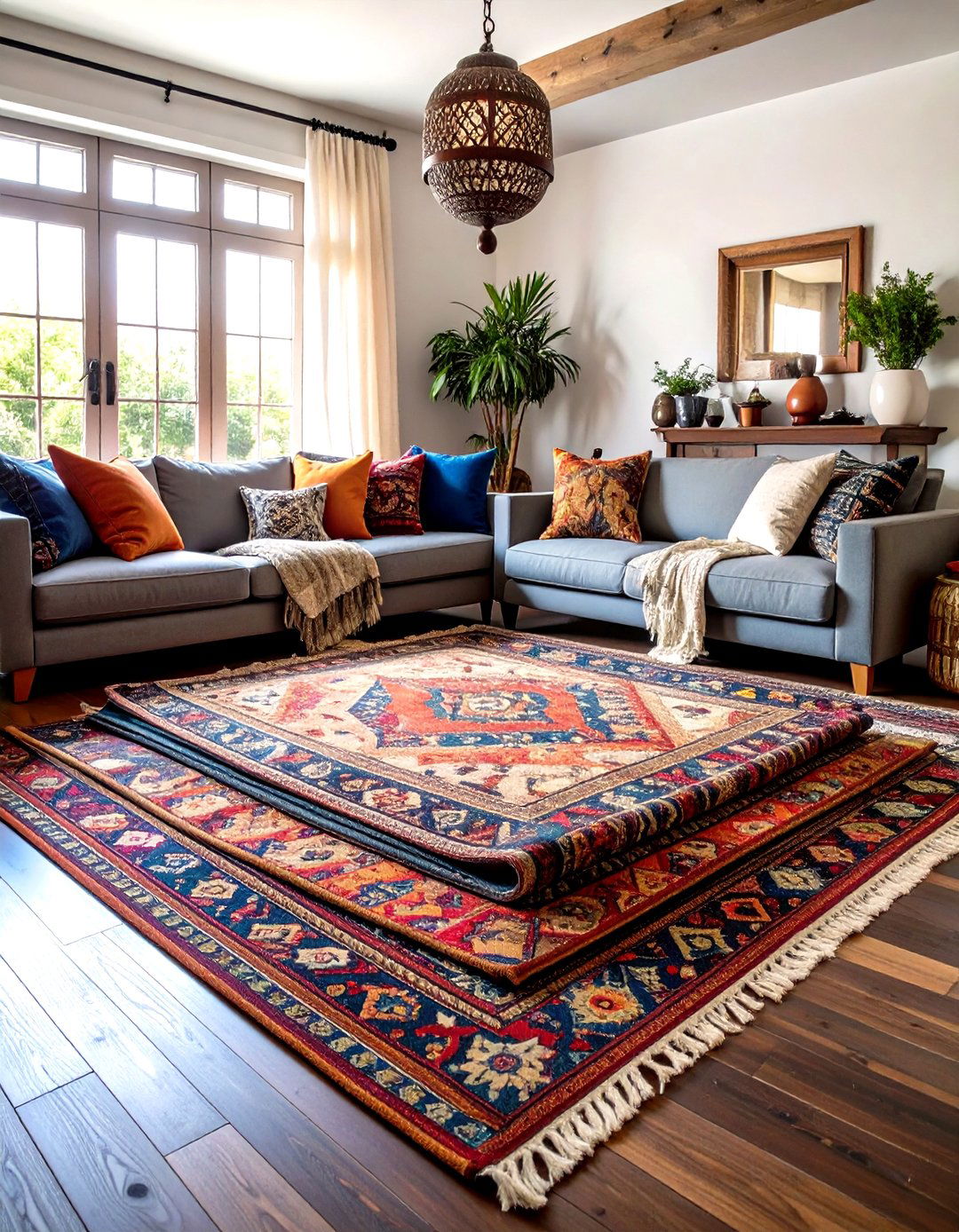
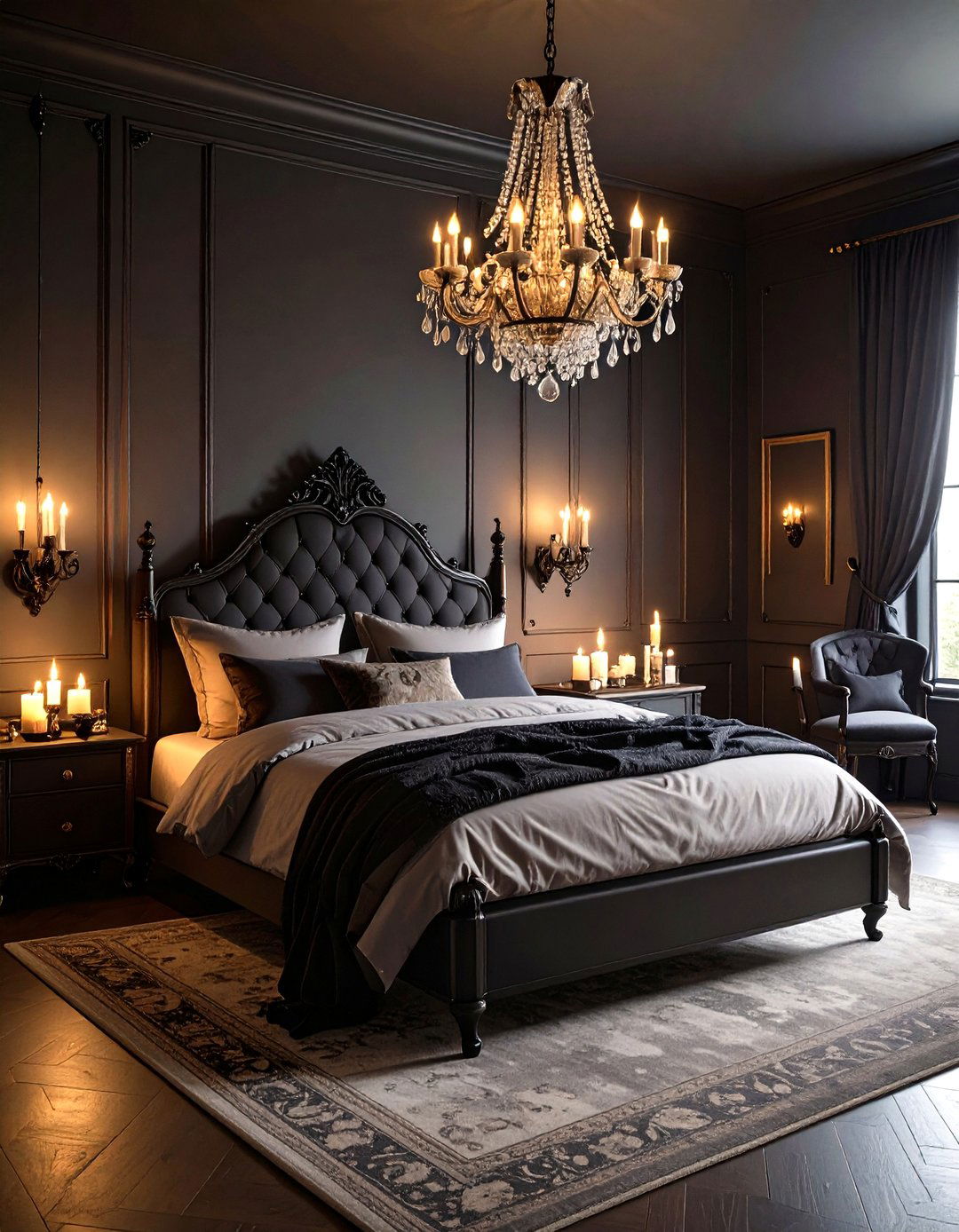
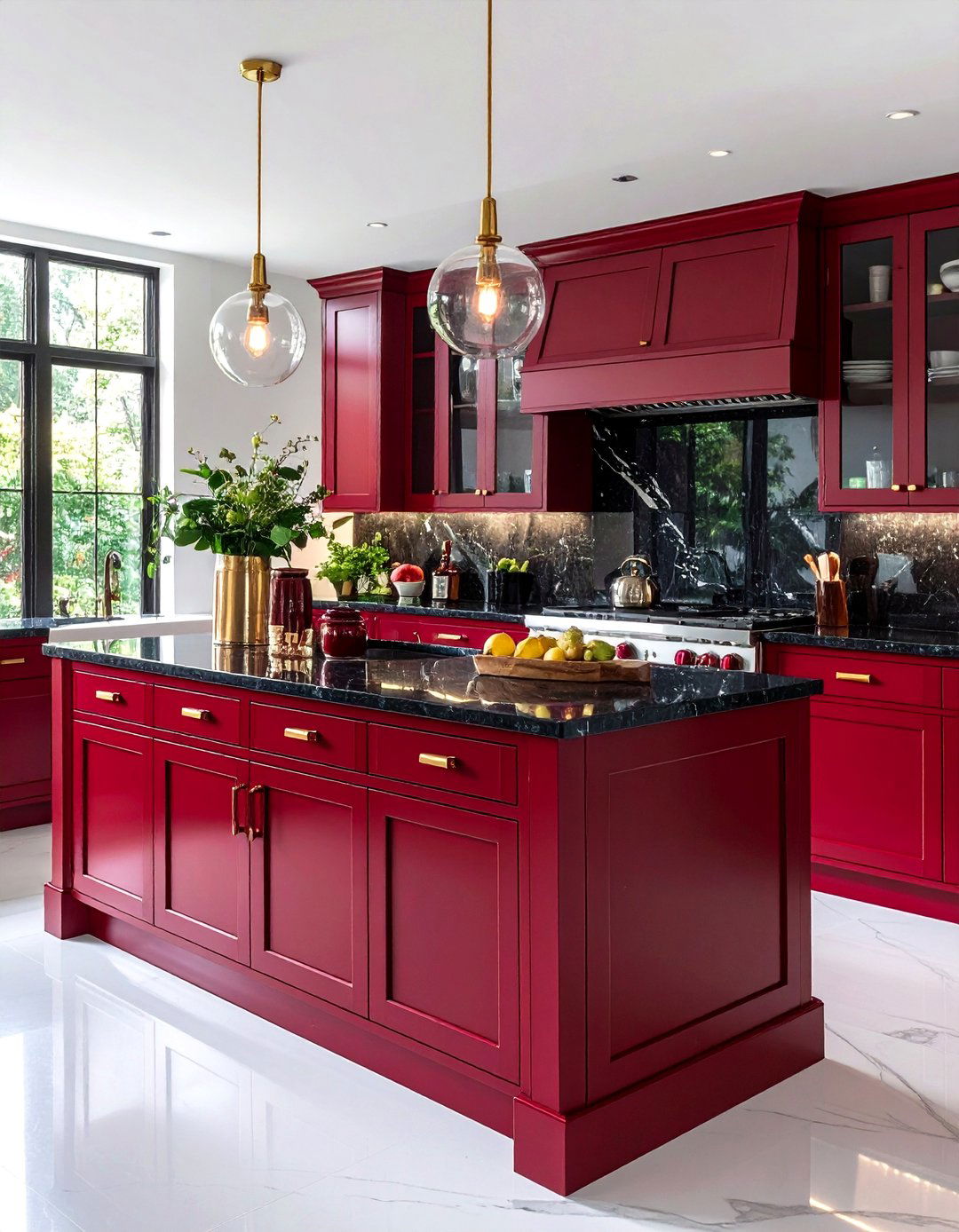
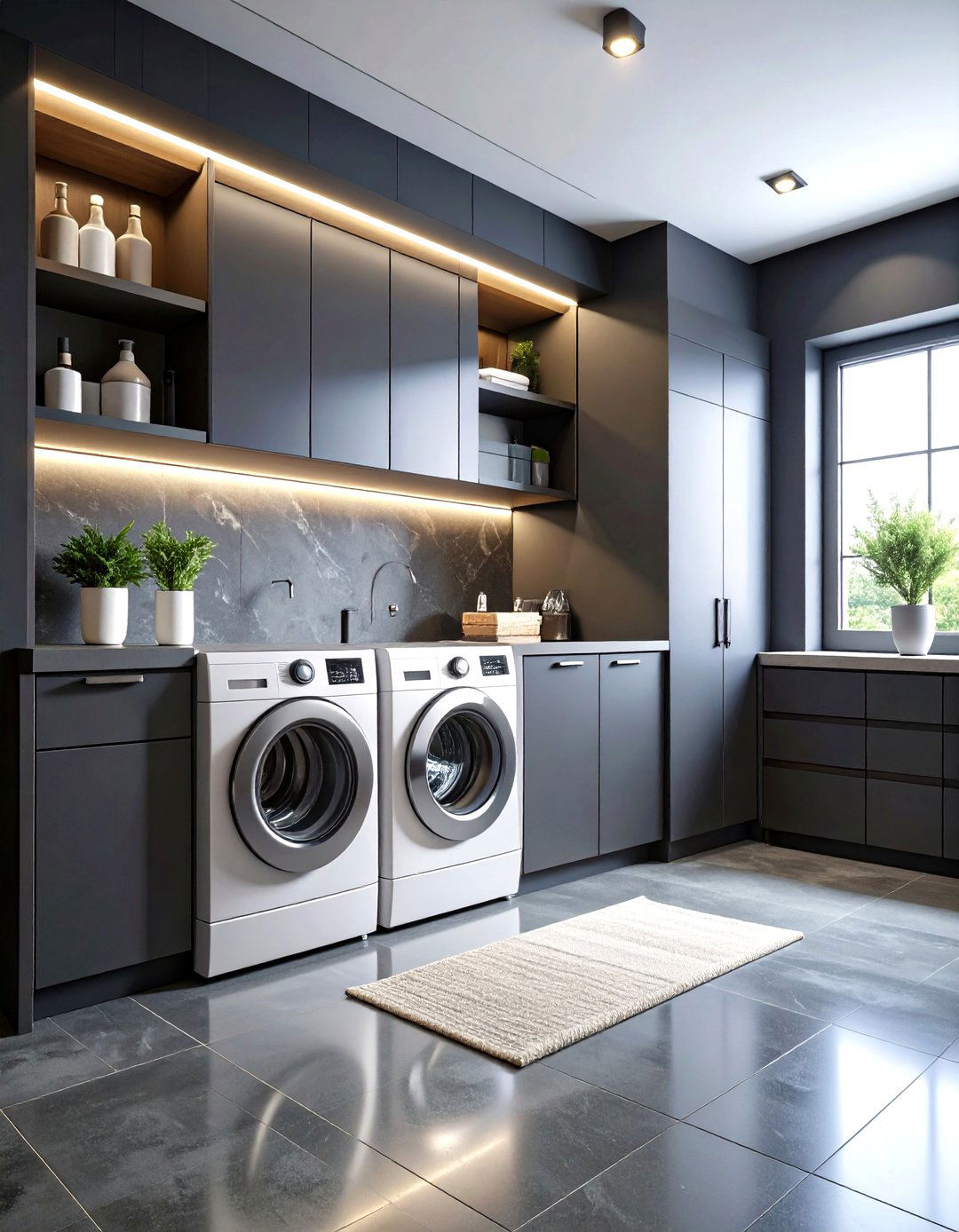
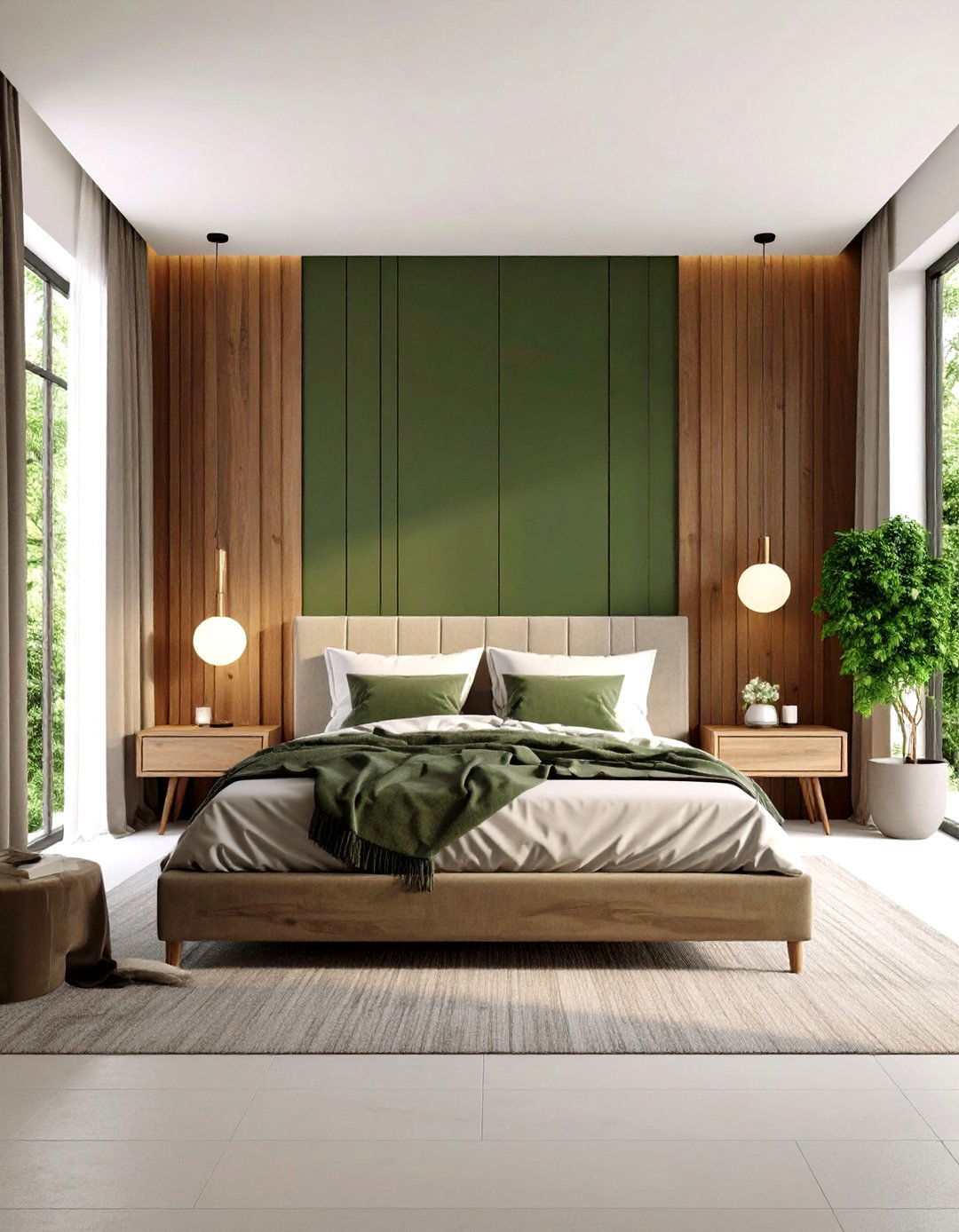
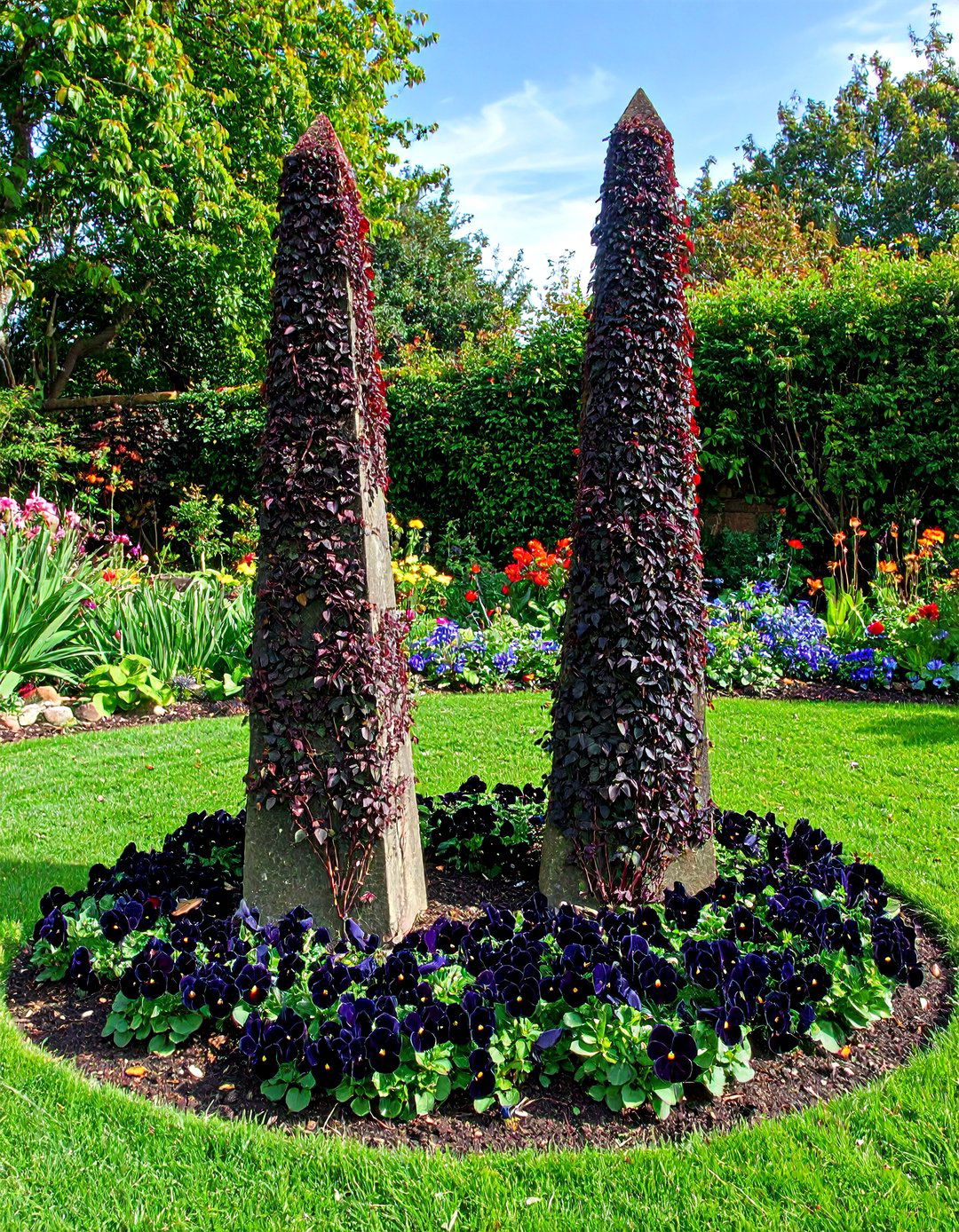



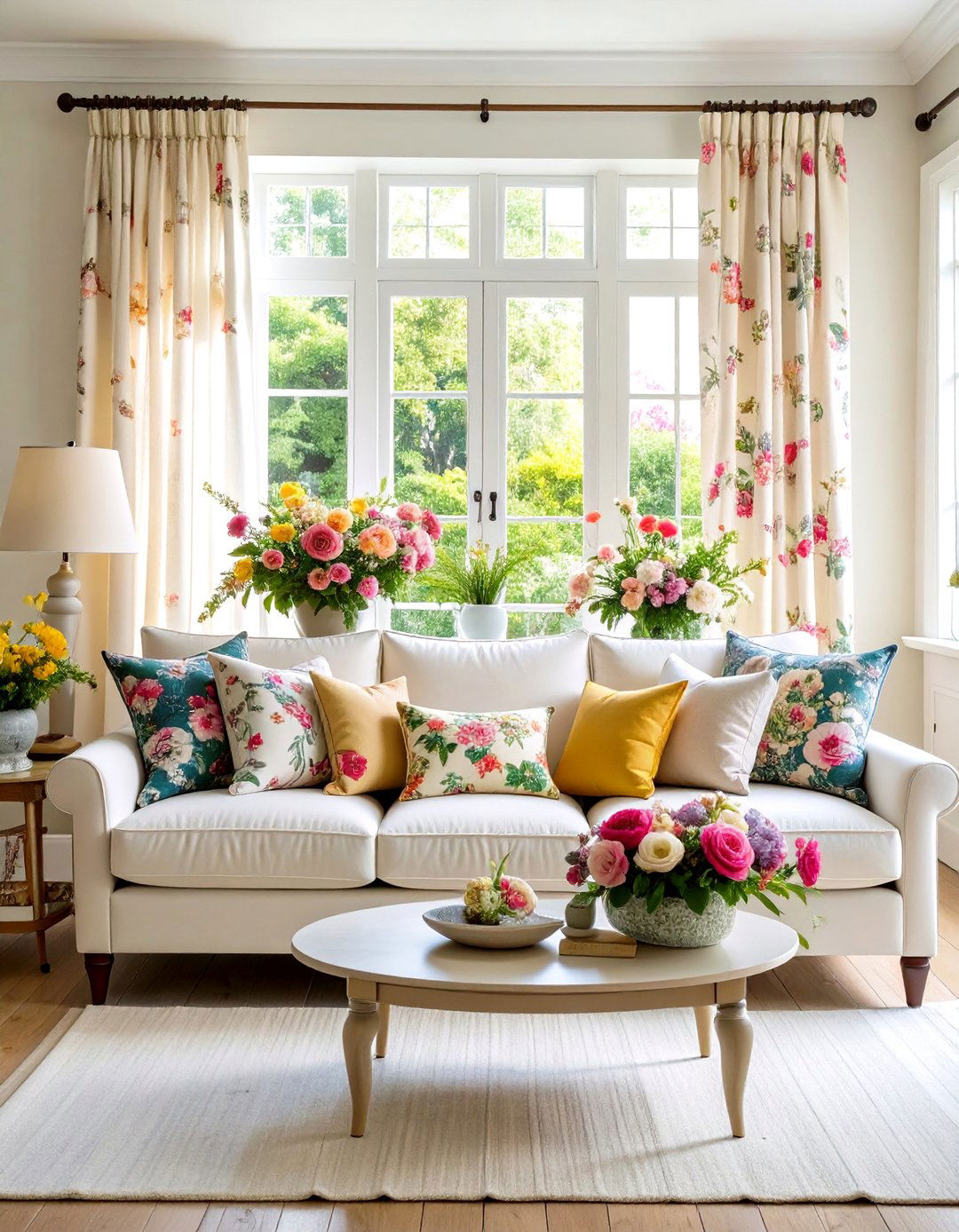
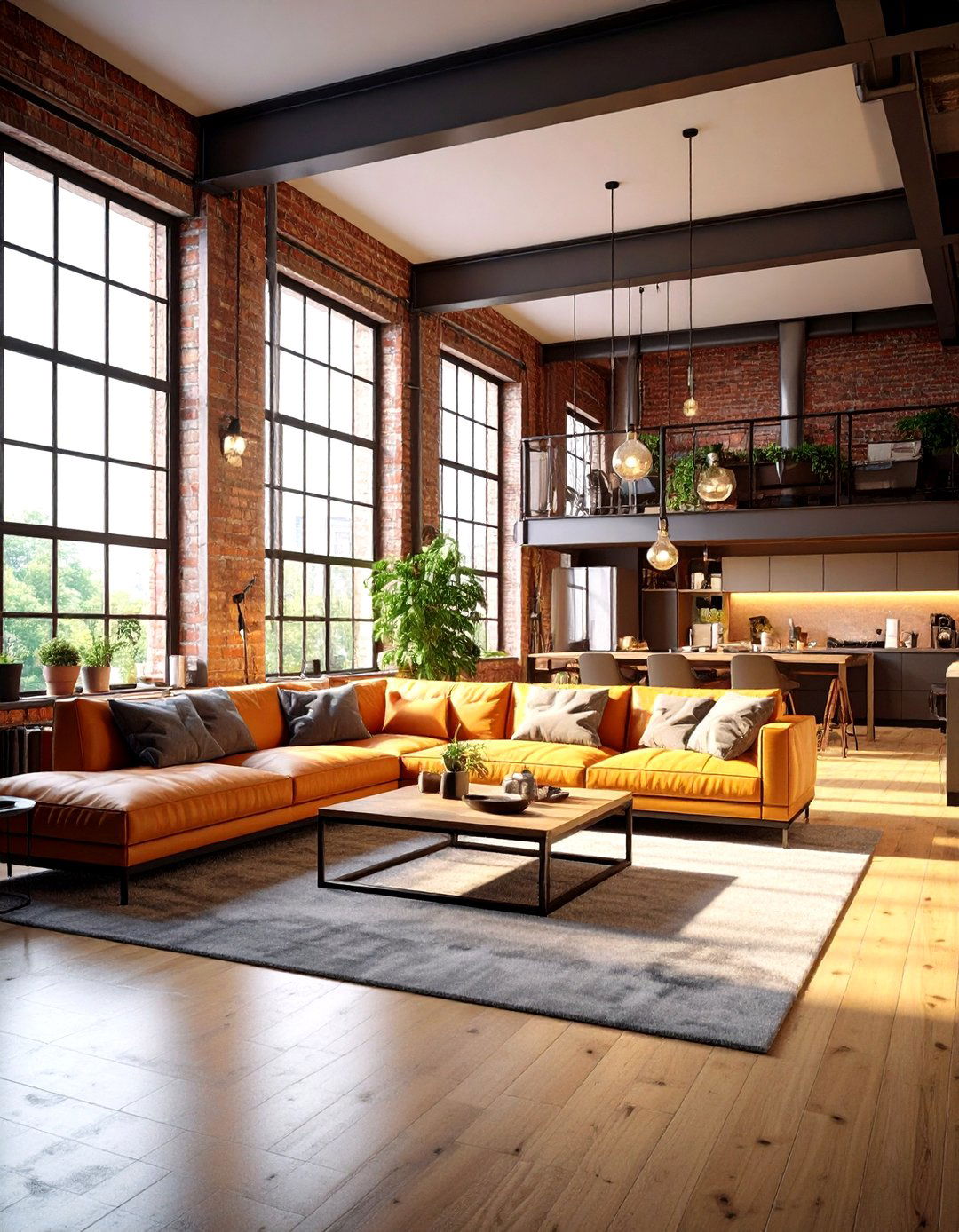
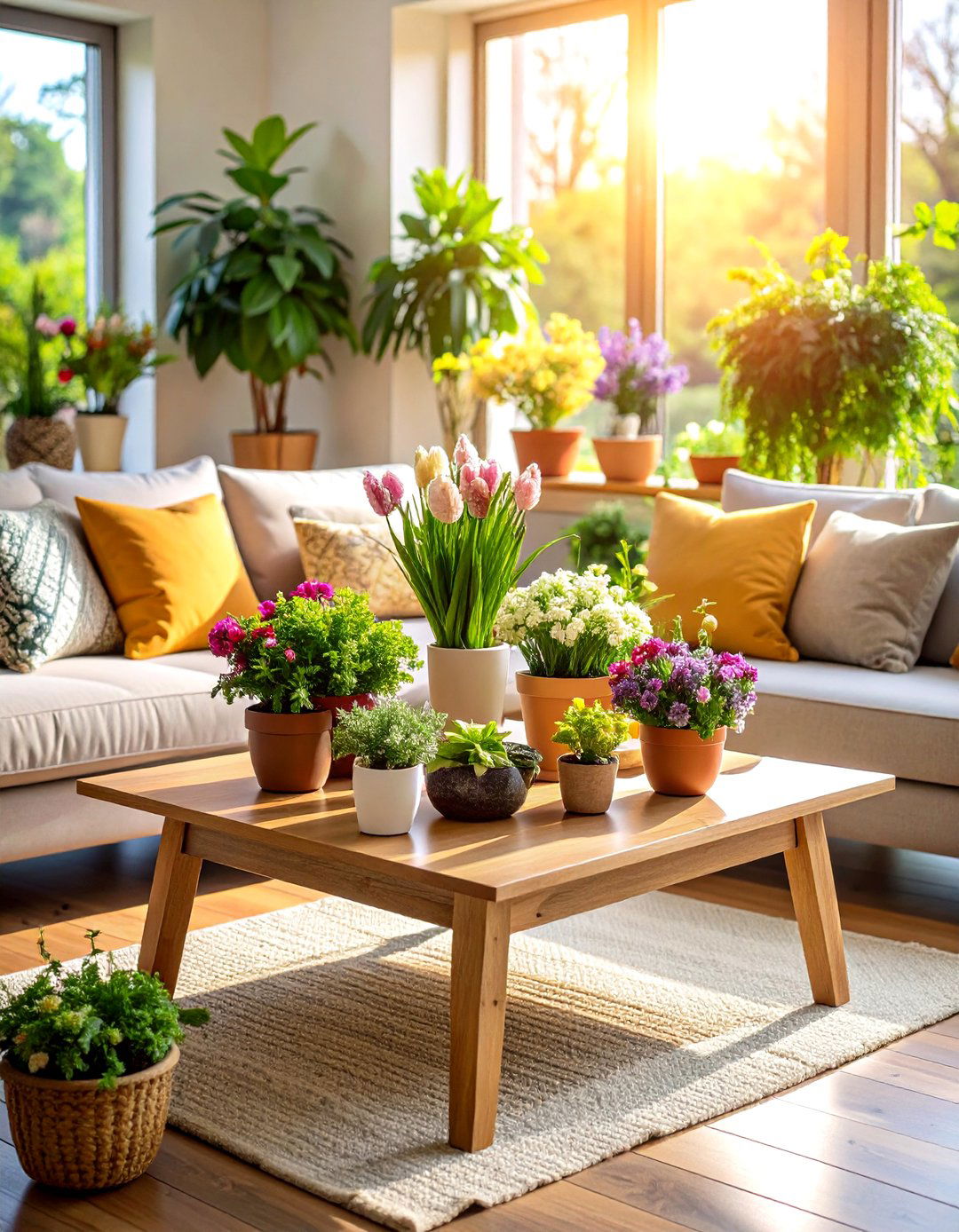
Leave a Reply